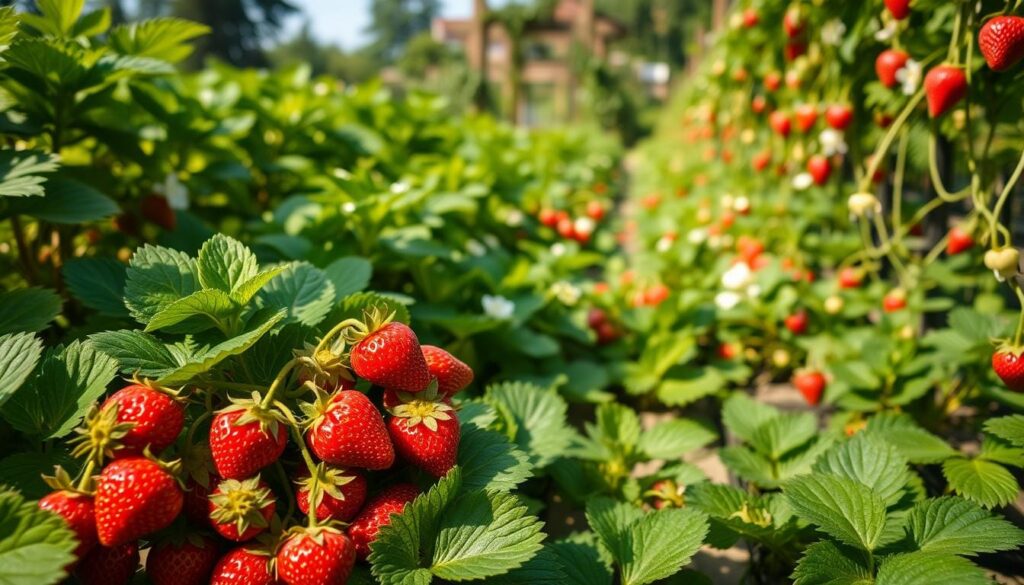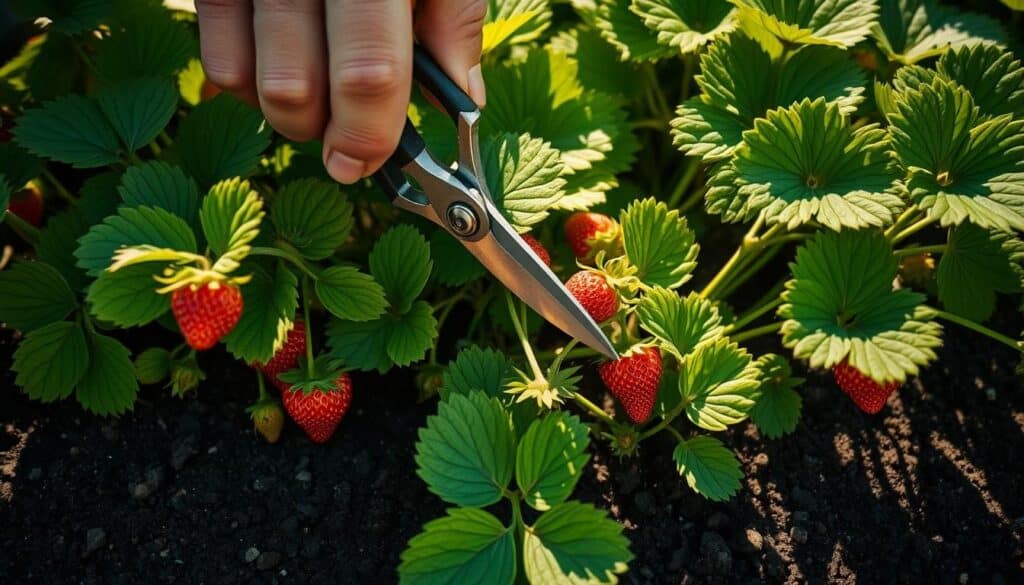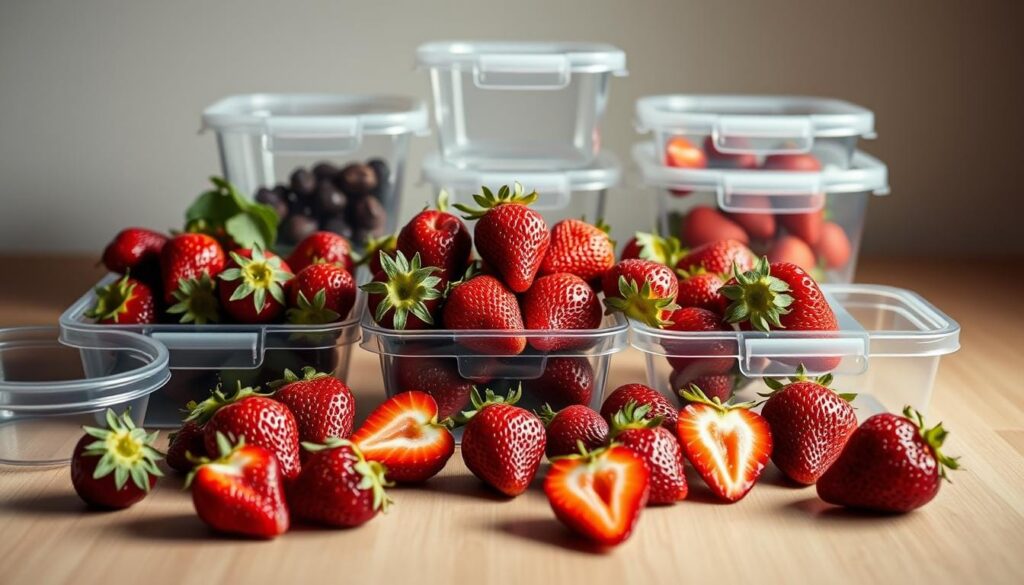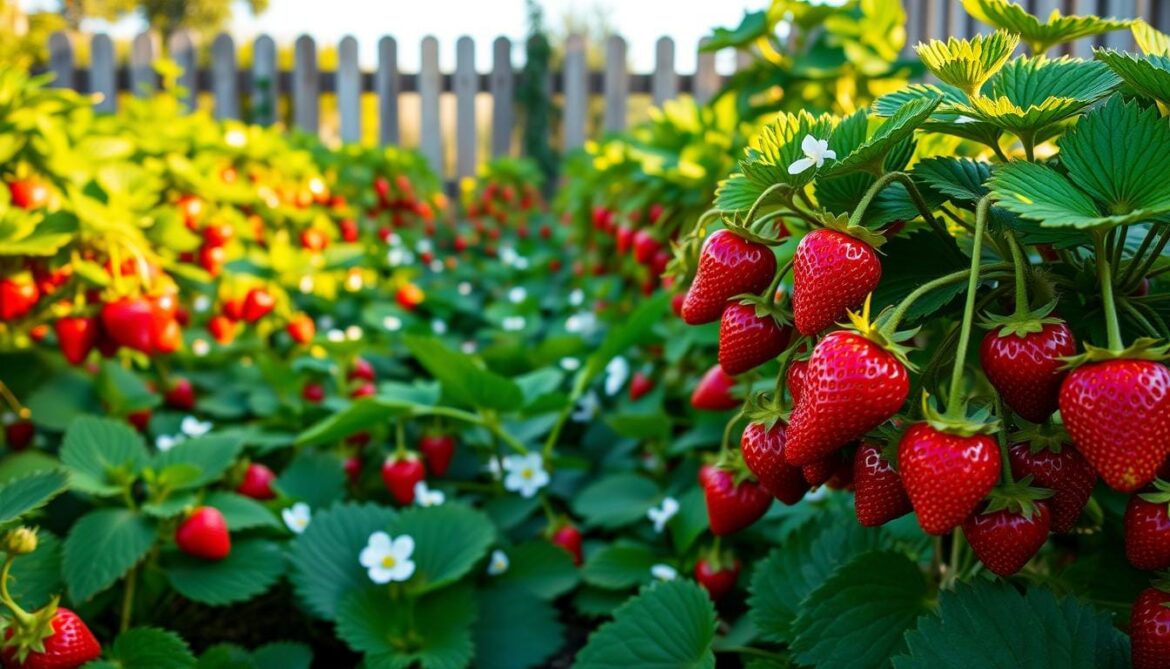There’s nothing like the taste of a sun-ripened strawberry from your garden. Everbearing strawberries let you enjoy this sweetness all year, not just in summer. They give you berries from spring to fall.
If you love fresh strawberries in pancakes, salads, or as a snack, this guide is for you. It shows how to grow everbearing strawberries for a year-round harvest.
Growing everbearing strawberries connects you to the earth. It’s a rewarding experience for both new and experienced gardeners. This article will help you choose the right varieties, care for them, and enjoy berries all year.
Let’s see how these plants turn your garden into a never-ending feast.
Key Takeaways
- Everbearing strawberries offer multiple harvests each growing season.
- Popular varieties like Everlig ht and Seascapethrive in diverse climates.
- Proper soil and sunlight maximize fruit production.
- These berries add flavor to both desserts and savory dishes.
- With the right care, you can enjoy fresh strawberries for months.
What Are Everbearing Strawberries?
Everbearing strawberries are special because they produce fruit many times in a growing season. They are different from June-bearing strawberries because they grow berries in spring, summer, and fall. This makes them great for gardeners who want berries all year without needing a lot of space.
Definition and Characteristics
These plants are known for their long fruiting periods. They have a few key traits:
- Harvest cycles: Two to three crops annually
- Plant size: Compact, manageable growth
- Runners: Fewer than June-bearers
- Berry size: Smaller but consistently sweet
Comparison with June-Bearing Strawberries
Knowing the differences helps gardeners see why they choose everbearing strawberries:
| Feature | Everbearing Strawberries | June-Bearing Strawberries |
|---|---|---|
| Harvest Time | Spring, summer, fall | Single late spring/early summer harvest |
| Yield Volume | Moderate but spread out | High-volume single harvest |
| Berry Size | Smaller berries | Larger berries |
| Flavor | Sweet and consistent | Intense flavor at peak |
| Growing Needs | Require consistent moisture | Less frequent watering |
Everbearing strawberries are perfect for gardens that want berries all year. They are great for small spaces and can be used in recipes or snacks all the time.
Benefits of Growing Everbearing Strawberries
Everbearing strawberries are a favorite among gardeners. They offer continuous harvesting opportunities, providing fruit from summer to fall. This means no waste and a steady supply for fresh use or preservation.
Experts say these strawberries are perfect for home gardens (strawberryplants.org).
Continuous Harvesting Opportunities
They produce berries for months, not just weeks. This makes picking easier and allows for enjoying fruit at its best. Home growers can enjoy berries for months without the rush of a short harvest.
Versatility in Culinary Uses
- Fresh eating directly from the plant
- Freezing for winter desserts
- Jams and jellies for gifts or storage
- Innovative dishes like salads or salsas
Health Benefits of Strawberries
| Nutrient | Health Impact |
|---|---|
| Vitamin C | Strengthens immunity |
| Antioxidants | Reduces cell damage |
| Fiber | Promotes digestive health |
Homegrown everbearing strawberries are packed with nutrients. They’re picked at the peak of ripeness. Growing your own means avoiding pesticides, ensuring cleaner, healthier fruit. They’re a great choice for snacks or meals.
Ideal Growing Conditions
For growing everbearing strawberries to succeed, you need to match their needs with your garden’s setup. These plants do best in certain soil and light conditions. They need the right pH and sun exposure.
Soil Requirements
Soil should be loose, drain well, and be rich in organic matter. The ideal pH is between 5.5 and 6.8 for best nutrient absorption. Before planting, test your soil with a home kit and adjust as needed:
- Add compost or aged manure to boost fertility.
- Avoid planting where tomatoes or peppers grew before to prevent disease.
- Use peat moss if your soil drains too slowly.
| pH Range | Amendment |
|---|---|
| Below 5.5 | Lime to raise pH |
| Above 6.8 | Aluminum sulfate or sulfur to lower pH |
Sunlight and Climate Preferences
Strawberries need 6–8 hours of direct sunlight each day. They thrive in USDA zones 4–9 but need adjustments in extreme weather. tips for successful everbearing strawberry cultivation include:
- In hot areas, use 30% shade cloth during the hottest summer months.
- In cold zones, cover plants with frost cloth during spring frosts.
“Soil pH is the unsung hero of strawberry health,” says Dr. Linda Blue, University of California Cooperative Extension.
How to Plant Everbearing Strawberries
Starting with growing everbearing strawberries requires careful planning. You need to choose the right plants and learn how to plant them. Follow these tips to make your garden a success all year round.

Choosing the Right Variety
Choose best everbearing strawberry varieties that fit your climate and needs. Here are some top picks:
- Ozark Beauty: Cold-hardy with sweet, medium-sized berries.
- Quinault: Tolerates heat and humidity, ideal for Southern gardens.
- Fort Laramie: Thrives in northern climates, producing early and late crops.
- Seascape: Compact plants for containers, perfect for small spaces.
“Remove first-year blossoms to boost root development, ensuring stronger harvests in subsequent seasons.”
Planting Time and Techniques
Plant in early spring in most areas or fall in milder climates. Here’s how to do it:
- Space plants 12-18 inches apart in rows 30-36 inches wide.
- Bury roots gently, keeping the crown at soil level to avoid rot.
- Use raised beds or containers for improved drainage and space efficiency.
For container growers: Use pots at least 12 inches deep with drainage holes. Mulch around plants to retain moisture and suppress weeds.
Watering Practices for Everbearing Strawberries
Learning how to care for everbearing strawberries begins with watering. It’s key for their growth and fruit. They do best when the soil is moist but not too wet. Adjust your watering based on whether they’re in the ground or in pots.
Irrigation Methods
- Drip irrigation: Sends water straight to the roots, keeping leaves dry.
- Soaker hoses: Soak the soil well without getting the leaves wet.
- Hand watering: Water the soil, not the leaves, to avoid diseases.
- Limit sprinklers: Don’t use overhead watering to prevent mold and rot.
Signs of Watering Issues
Growing everbearing strawberries means keeping an eye on moisture. Look out for:
- Overwatering: Yellow leaves, soggy soil, or root rot.
- Underwatering: Wilting, small berries, or curled leaves.
Keep the soil moist with 1-1.5 inches of water each week when they’re growing fast. During fruiting, check the soil 1-2 inches deep. If it’s dry, it’s time to water. Use straw or pine needles to keep moisture in and weeds out. Pots dry out faster, so check them every 2-3 days.
Keep the soil moist during fruiting to avoid shriveled berries. Let the soil dry a bit between waterings to prevent root problems. Water in the early morning for best absorption.
Fertilizing Everbearing Strawberries
Properly nourishing plants ensures everbearing strawberries stay productive year-round. Strategic fertilization is key to how to care for everbearing strawberries while maximizing flavor and yield. 
Best Types of Fertilizers
Choose between organic or synthetic options tailored to plant needs:
- Organic: Use compost, aged manure, or fish emulsion. Look for organic berry fertilizers labeled for fruiting plants.
- Conventional: Opt for balanced 10-10-10 NPK blends or high-phosphorus formulas like 5-10-10. Avoid high-nitrogen mixes that promote leaf growth over fruiting.
Incorporate iron-rich supplements if leaves yellow—this prevents chlorosis and supports photosynthesis.
Timing and Application Tips
Follow this schedule for optimal results:
- Apply a base fertilizer at planting time mixed into soil.
- Feed lightly after each harvest cycle to replenish nutrients.
- Avoid midsummer nitrogen boosts to prevent frost damage to new growth.
Side-dress plants 6 inches away from crowns to avoid burn. Always water after applying fertilizer. Soil tests help adjust rates based on existing nutrient levels. Signs like pale leaves or sparse berries signal possible deficiencies—adjust fertilization promptly.
Pest and Disease Management
Keeping everbearing strawberry plants safe from pests and diseases is key for their health and a good harvest. Important steps include spacing plants right, rotating crops, and keeping the area clean. These actions help protect your strawberries and ensure a successful crop.
Common Pests and How to Combat Them
Pests can harm plants fast. Spot and fix problems early:
- Slugs/Snails: Look for chewed leaves and shiny trails. Use diatomaceous earth or copper barriers.
- Aphids: Find curled leaves and sticky spots. Blast with water or use insecticidal soap.
- Spider Mites: See yellow spots on leaves. Spray neem oil or introduce predatory mites.
- Birds
Use netting or reflective tape to keep birds away.
Diseases Affecting Strawberries
Be on the lookout for these diseases and act fast to stop them from spreading:
| Disease | Symptoms | Solutions |
|---|---|---|
| Gray Mold (Botrytis) | Fuzzy gray mold on fruit/leaves | Remove infected parts; improve air circulation. |
| Powdery Mildew | White powdery coating on leaves | Spray sulfur-based fungicides or potassium bicarbonate. |
| Verticillium Wilt | Yellow leaves, stunted growth | Remove affected plants; rotate crops away from solanaceae family plants. |
Keep the area clean, remove debris, and avoid watering from above to lower disease risk. Rotate crops every 3–4 years to avoid soil-borne diseases. Regular checks and quick action help keep your plants healthy for a long time.
Pruning and Maintenance

To keep everbearing strawberries thriving, you need to prune and maintain them regularly. Pruning everbearing strawberries helps them focus on growing fruit instead of leaves. Start by removing dead leaves and spent berries after each harvest to stop disease.
When and How to Prune
Here’s how to prune effectively:
- Cut off runners right away unless you’re using them to grow new plants. Use clean shears to avoid spreading disease.
- In late summer, trim off yellow leaves to encourage new growth.
- After the fall harvest, remove all old foliage. This lets the crowns rest during winter.
If your plants start to decline after 3-4 years, it’s time to start fresh. Replant new strawberries in fresh soil.
Importance of Maintenance for Yield
Proper care for everbearing strawberries includes:
- Refresh mulch every month to keep the soil moist and weed-free.
- Check your plants weekly for pests or fungal spots.
- Clean up dropped fruit seasonally to prevent rot.
| Task | In-Ground Beds | Containers |
|---|---|---|
| Pruning Frequency | After each harvest cycle | Every 2-3 weeks |
| Mulching | 3″ straw or compost layer | Use shredded bark in pots |
| Weed Control | Hand-pull between plants | Scratch surface lightly |
| End-of-Season Prep | Cut foliage to ground level | Repot in fresh soil annually |
Regular maintenance helps your plants live longer and produce more fruit. Adjust your care routine based on how you grow them to keep them productive all year.
Harvesting Everbearing Strawberries
Learning how to pick strawberries is essential for enjoying them fully. The right timing and method can make your strawberries taste better and keep your plants healthy. Here’s how to pick them right:
Signs of Ripeness
- Color: Berries should be fully red, with no white or green patches.
- Touch: Slightly soft flesh signals peak sweetness.
- Aroma: A sweet, fruity scent confirms readiness.
How to Harvest Without Damaging Plants
Use clean scissors or your fingertips to snip stems 1/4 inch above the berry. Don’t pull berries, as it can harm the plant. Picking in cool morning or evening temperatures helps keep the flavor.
“Check plants every 2-3 days during peak season to catch berries at their best.”
Be gentle when handling berries to avoid bruising. Sort them right away: use perfect ones for fresh eating, and slightly damaged ones for jams or freezing. Remove any overripe or rotting fruit to stop disease from spreading.
Storage and Preservation Tips
Keeping everbearing strawberries fresh starts with how you handle them after picking. These tips help keep flavor and quality, whether you eat them right away or save them for later.

Best Practices for Fresh Strawberries
To keep strawberries crisp, follow these steps:
- Refrigerate at 32–36°F (0–2°C) within 2 hours of picking.
- Line containers with paper towels to absorb moisture and prevent rot.
- Store unwashed in shallow containers to avoid crushing delicate berries.
Never wash berries until you’re ready to use them to stop mold. Stored right, everbearing strawberries stay fresh for 3–7 days.
Freezing Methods for Long-Term Storage
Freezing keeps strawberries at their best. Here are your options:
- Whole berries: Freeze on parchment-lined trays first, then move to airtight containers.
- Sliced berries: Mix with sugar before freezing to keep texture.
- Purée: Blend and freeze in ice cube trays for smoothies or baking.
| Method | Storage Time | Best For |
|---|---|---|
| Fresh refrigeration | 3–7 days | Weekend harvests |
| Freezing | 8–12 months | Long-term use in recipes |
| Dehydration | 1 year+ | Baking or snacks |
Use up extra berries by making jams or infused vinegars. This way, you can enjoy them all year.
Recipes with Everbearing Strawberries
Everbearing strawberries open up a world of flavors in your kitchen. They grow for months, giving you endless chances to try new recipes. For those growing them hydroponically,
Smoothies and Desserts
- Blend ripe berries with yogurt, banana, and spinach for a nutrient-packed smoothie.
- Highlight the berries’ natural sweetness in desserts like strawberry shortcake or layered parfaits with granola.
- Pair with dark chocolate in truffles or fold into pancake batter for summer breakfasts.
Savory Pairings
Balance their tartness with herbs like mint or basil in salads. Try:
- Salsa with red onion and jalapeño as a topping for grilled chicken.
- Vinaigrette using pureed berries for salad dressings.
- Cold soups blended with cucumber and dill for a refreshing summer starter.
Small-batch preserves are perfect for their continuous harvest. Jams made with lemon zest or brandy add depth for winter use. Their year-round availability lets you cook with peak freshness, whether crafting cocktails or holiday desserts.
Common Questions About Everbearing Strawberries
Growing everbearing strawberries can bring up some questions. Here’s a quick guide to help solve these challenges and ensure your plants thrive.

FAQs Sighted by New Growers
- Yield expectations: Most plants produce 20–30 berries yearly with proper care.
- Plant lifespan: Expect 2–3 productive years before renewal is needed.
- Runners management: Trim excess runners to direct energy toward fruiting.
- Container growing: Use 12-inch pots with drainage for healthy growth.
- Pollination needs: No cross-pollination required—they self-pollinate naturally.
- First harvest timeline: First berries typically appear 3–4 months after planting.
- Propagation method: Root runners in soil to grow new plants easily.
Troubleshooting Common Issues
Address problems early with these solutions:
- Poor fruit set: Ensure consistent moisture and pollination support.
- Small berries: Thin overcrowded plants and apply balanced fertilizer.
- Flavor issues: Harvest when fully red for peak sweetness.
- Yellowing leaves: Adjust watering and treat fungal issues promptly.
- Stunted growth: Fertilize with a 10-10-10 formula if signs of deficiency appear.
- Flowers but no fruit: Gently shake flowers to aid pollination or use a soft brush.
Dealing with regional challenges? In hot zones, provide afternoon shade. In short-season areas, use row covers. High humidity? Improve drainage to avoid root rot. These tips for successful everbearing strawberry cultivation help overcome most hurdles. With patience and basic care, everbearing strawberries reward gardeners with year-round fruit.
Seasonal Care for Everbearing Strawberries
Seasonal changes require specific care for everbearing strawberries to thrive all year. Follow these steps to keep your plants healthy and productive.
Winterizing Your Strawberry Plants
To protect plants from cold, apply a 4-6 inch layer of straw, pine needles, or shredded leaves. Wait until after the first frost but before it gets too cold. For plants in containers, consider:
- Moving pots to sheltered spots like unheated garages
- Burying containers in garden soil
- Wrapping pots in burlap or frost cloth
Remember, don’t mulch too early to avoid stem rot.
Spring Care Tips for Optimal Growth
Start removing mulch when daytime temperatures are above 40°F. Use a balanced fertilizer like 10-10-10 when new growth starts. Check for winter damage and replace dead plants with new ones from everbearing strawberry plants for sale. Watch for pests like slugs with organic baits.
First-year plants need extra mulch protection, while established plants can handle lighter coverings.
In summer, keep plants watered and use shade cloth for hot days. In fall, trim dead leaves and reapply mulch before winter. Always buy disease-free plants from trusted growers like White Flower Farm or RarePedia for a strong start.
Conclusion: Your Everbearing Strawberry Journey
Everbearing strawberries give you fresh berries all year with the right care. Start by preparing the soil well and keeping up with maintenance. This guide has tips on planting, fighting pests, and adjusting for the seasons to boost your harvest.
Recap of Key Points
Everbearing strawberry plants love full sun and rich, well-drained soil. Make sure to space them right and water them well to avoid problems. Regular pruning also helps improve the taste of your berries.
Don’t forget to protect them in winter and fertilize in spring. For more on transplanting, check out Chikus Garden’s guide. It helps with healthy root growth.
Encouragement for Home Gardeners
Starting with everbearing strawberry plants is easy, even for new gardeners. Start small with a container or raised bed. This lets you try things out before you grow more.
Homegrown berries are way better than store-bought ones. They’re fun to grow with your family. Make sure to buy from trusted places to get healthy plants. With a little patience and care, you’ll get a steady supply of delicious berries.

